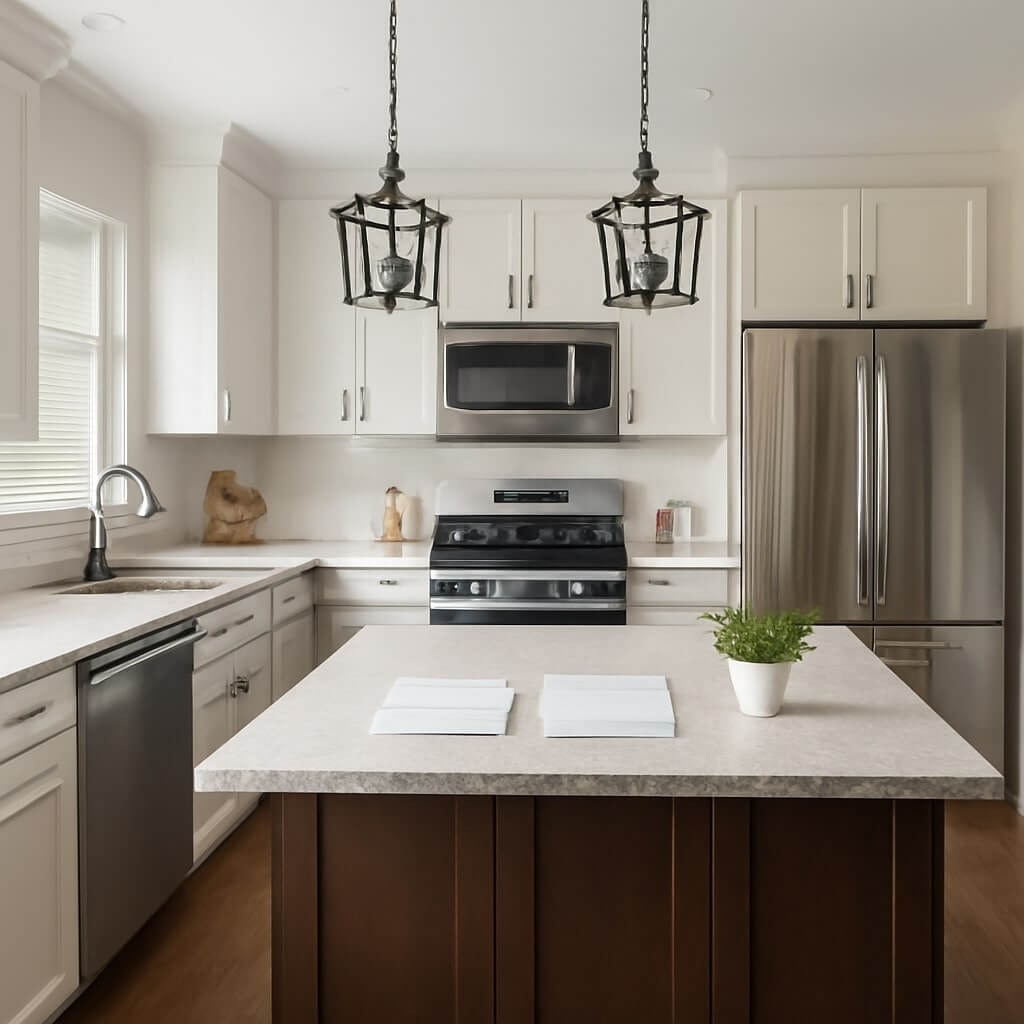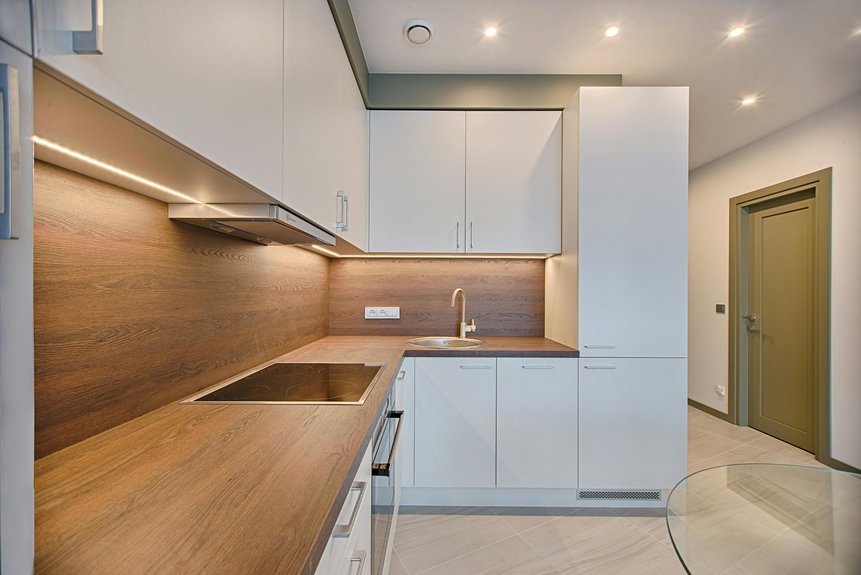When planning a kitchen remodel in 2025, you’ll find a variety of financing options at your disposal. Each choice comes with its own advantages and disadvantages, impacting your budget and overall financial strategy. From personal loans to government-backed programs, understanding these options is essential for making informed decisions. As you explore these avenues, consider which financing method aligns best with your long-term goals and needs. What will work best for your situation?
Key Takeaways
- Explore personal loans for flexible financing without tapping into home equity, ideal for quick access to funds and straightforward applications.
- Consider credit cards for convenient remodeling expenses while being cautious of high-interest rates; rewards programs can offer additional benefits.
- Utilize home equity loans for lower interest rates and potential tax benefits, ensuring you meet eligibility requirements such as creditworthiness.
- Investigate FHA 203(k) loans for combined purchase and renovation financing with lower down payment requirements to simplify funding.
- Look into peer-to-peer lending for competitive interest rates and customized loan terms tailored to your specific remodeling needs.
Personal Loans
When considering kitchen remodel financing, personal loans can be a viable option for many homeowners.
One of the key personal loan benefits is their flexibility; you can use the funds for various renovation costs without restrictions. Additionally, the application process is often straightforward, allowing you to access funds relatively quickly.
However, it’s essential to understand loan eligibility requirements, which typically include a good credit score and stable income. By meeting these criteria, you can secure a loan with favorable terms, making your kitchen remodel more affordable and achievable without tapping into your home’s equity.
Home Equity Loans
Home equity loans can be a viable option for financing your kitchen remodel, offering advantages such as lower interest rates compared to personal loans.
Understanding the application process is essential to guarantee a smooth experience when tapping into your home’s equity.
Advantages of Home Equity
While many homeowners seek financing options for their kitchen remodels, tapping into your home equity can provide significant advantages. By leveraging equity accumulation, you can access funds at lower interest rates compared to personal loans.
Additionally, a remodel can boost your home value, making it a sound investment.
- Lower interest rates: Home equity loans typically offer better rates than unsecured loans.
- Potential tax benefits: Interest may be tax-deductible, depending on your situation.
- Increased home value: A well-planned remodel can enhance your property’s market appeal and worth.
Consider these factors when exploring your financing options.
Application Process Overview
Understanding the application process for a home equity loan is essential for making informed financial decisions.
To start, you’ll need to meet specific application requirements, such as proving income, creditworthiness, and the amount of equity in your home. Collecting necessary documents, like tax returns and bank statements, can streamline the process.
Once you’ve submitted your application, the approval timeline typically ranges from a few days to several weeks, depending on your lender’s policies. During this period, lenders will assess your financial situation and property value before providing a final decision, so being prepared can notably expedite your experience.
Home Equity Lines of Credit (HELOC)
A Home Equity Line of Credit (HELOC) offers you flexible borrowing options, allowing you to access funds as needed for your kitchen remodel.
It typically features variable interest rates, which can affect your repayment amounts over time.
Understanding these factors is essential for managing your budget and ensuring the project stays within financial limits.
Flexible Borrowing Options
How can you leverage the value of your home to finance a kitchen remodel? A Home Equity Line of Credit (HELOC) offers flexible borrowing options, allowing you to tap into your home’s equity.
This alternative financing solution provides:
- Flexible repayment terms: You can borrow and repay as needed, adapting to your budget.
- Lower interest rates: HELOCs typically have lower rates compared to personal loans or credit cards.
- Access to funds: Draw from your credit line whenever necessary, making it easy to manage unexpected expenses.
Using a HELOC can be a strategic way to fund your kitchen transformation.
Interest Rates Explained
Interest rates on Home Equity Lines of Credit (HELOC) can greatly impact your borrowing costs and overall project budget. Understanding current interest rate trends is essential, as they fluctuate based on economic conditions and Federal Reserve policies.
Typically, HELOCs offer variable rates that may rise or fall, affecting your monthly payments. However, some lenders provide fixed rates for a portion of the balance, offering stability.
When considering a HELOC for your kitchen remodel, evaluate how these interest rates align with your financial goals and project timeline. This knowledge empowers you to make informed decisions about your financing options.
Repayment Considerations
Maneuvering the repayment landscape of a Home Equity Line of Credit (HELOC) is essential for effective financial planning. Understanding your repayment timeline and how it fits into your overall budget can help you manage your finances wisely.
Prioritizing loans, including your HELOC, guarantees you address higher-interest debt first, potentially saving you money in the long run.
- Assess your monthly payment capabilities.
- Create a repayment schedule that fits your budget.
- Monitor interest rates and market conditions.
Credit Cards
Using credit cards for your kitchen remodel can be a flexible and convenient financing option. You can leverage credit card rewards to offset costs or earn cash back on your purchases. However, be cautious of high-interest rates, especially if unexpected emergency expenses arise.
| Credit Card Type | Benefits | Considerations |
|---|---|---|
| Rewards cards | Earn points/cash | High-interest rates |
| 0% APR cards | No interest period | Limited time offer |
| Low-interest cards | Lower rates | May lack rewards |
| Store cards | Discounts | High-interest rates |
Make informed choices to maximize your benefits.
FHA 203(k) Loans
If you’re considering a more extensive renovation for your kitchen, FHA 203(k) loans offer a viable alternative to credit cards.
These loans allow you to finance both the purchase and renovation costs, making them attractive for significant upgrades.
Here are some key FHA benefits:
- Lower down payment requirements
- Flexible loan eligibility criteria
- Inclusion of renovation costs in your mortgage
Utilizing an FHA 203(k) loan can help you manage your budget effectively while enhancing your kitchen’s value.
Be sure to check your eligibility, as these loans cater to various financial situations, making them accessible for many homeowners.
Cash-Out Refinance
One effective way to fund your kitchen remodel is through a cash-out refinance, which allows you to tap into your home’s equity.
This strategy can provide substantial cash out benefits, letting you access funds for renovations while potentially lowering your interest rate. By refinancing your existing mortgage, you can convert equity into usable cash, enabling you to invest in quality materials and labor.
However, it’s important to weigh the costs and risks associated with refinancing strategies, including closing costs and the potential impact on your monthly payments.
Government Grants and Programs
Many homeowners overlook government grants and programs that can provide financial assistance for kitchen remodels, yet these resources can greatly reduce out-of-pocket expenses.
Understanding your funding eligibility is essential for accessing these benefits. Here are some options to reflect on:
- Energy Efficiency Grants: Funding for energy-saving appliances and renovations.
- HUD Programs: Assistance for low-income families to improve living conditions.
- Local Initiatives: State or city-specific programs aimed at home improvement.
Contractor Financing
While government grants and programs can ease financial burdens, contractor financing offers another viable option for funding your kitchen remodel. Many contractors provide financing options directly, allowing you to spread costs over time.
However, it’s crucial to evaluate the contractor’s reputation before committing. A well-regarded contractor can provide favorable terms and guarantee a smoother remodeling experience. Look for reviews and testimonials to gauge reliability.
Be sure to compare different financing options, as interest rates and repayment terms can vary greatly. This approach can help you secure a manageable payment plan without compromising on the quality of your kitchen renovation.
Peer-to-Peer Lending
Peer-to-peer (P2P) lending has emerged as a flexible financing option for homeowners looking to remodel their kitchens. This model connects you directly with individual investors, often resulting in competitive interest rates and customized loan terms.
It’s crucial to evaluate peer reviews of P2P platforms to guarantee reliability and trustworthiness.
- Access to diverse funding sources
- Potentially lower interest rates than traditional banks
- Greater flexibility in repayment options
Savings and Budgeting Strategies
When planning a kitchen remodel, setting clear financial goals is essential for staying on track.
By defining how much you want to save and by when, you can better allocate your resources.
Additionally, tracking your expenses effectively will help you identify areas where you can cut costs and maximize your savings.
Setting Clear Financial Goals
Establishing clear financial goals is essential for a successful kitchen remodel. Effective budgeting techniques and goal prioritization help you stay on track.
Begin by identifying your total budget and breaking it down into manageable categories.
- Set a realistic savings target
- Allocate funds based on priority needs
- Monitor progress regularly
Tracking Expenses Effectively
Once you’ve set clear financial goals, tracking expenses becomes essential to ensuring you stick to your budget during the kitchen remodel.
Effective expense tracking allows you to monitor where your money goes, helping you identify areas for potential savings. Use budgeting apps or spreadsheets to categorize your spending, ensuring you keep everything in check.
Regularly review your expenses against your budget management plan to adjust as needed. This proactive approach not only prevents overspending but also empowers you to make informed decisions throughout the remodel process, ultimately aligning your project with your financial objectives more effectively.
Conclusion
In 2025, exploring various financing options for your kitchen remodel is essential to finding the best fit for your needs. Whether you choose personal loans for quick access, home equity options for lower rates, or government-backed loans for combined financing, each choice has its pros and cons. By carefully evaluating the terms and aligning them with your financial goals, you can make an informed decision that not only enhances your kitchen but also supports your long-term financial stability.




